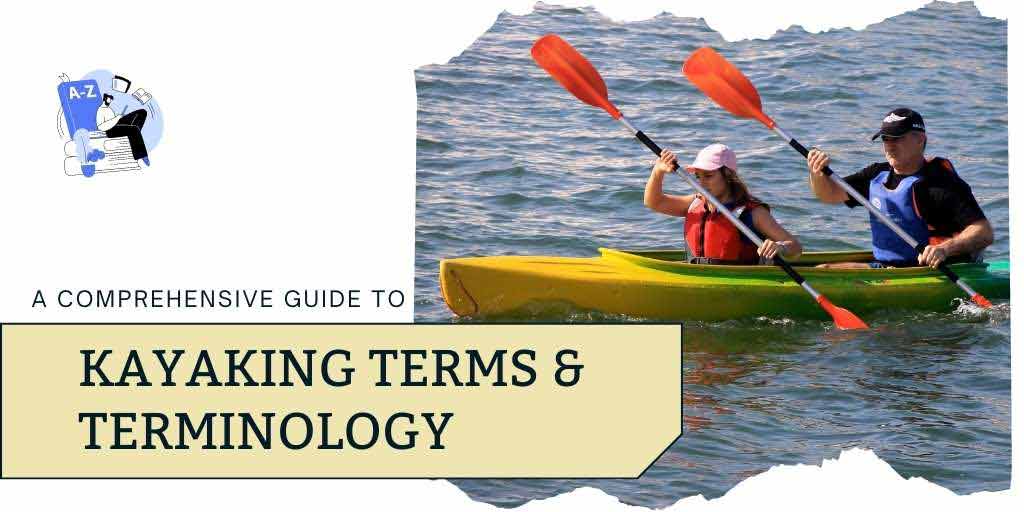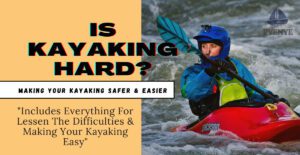We’ve all been there before. You’re out on the water, enjoying a beautiful day kayaking when suddenly you hear someone yell, “Eddy out!” But what does that even mean? If you’re new to the sport, there are a lot of kayaking terms that can be confusing.
But don’t worry, we’re here to help. In this blog post, we’ll introduce you to some of the essential kayaking terms and terminology so that you can hit the water with confidence. Let’s begin;

Jump To A Section
A Simple Introduction to Kayaking Terms
Kayaking can be a very technical sport, with its own set of jargon and technical terms. Don’t let that dissuade you from kayaking, though! It’s an amazing sport that anyone can enjoy.
To help you out, we’ve put this comprehensive guide to kayaking terms and terminology. By the end of this guide, you’ll be able to understand and use kayaking terms like a pro. Let’s start with the fundamentals;
Kayak
kayaks are small, narrow boats that are paddled with a double-bladed paddle. Thus, kayaking is the act of paddling a kayak.
They are designed to be stable and easy to maneuver, making them a great choice for exploring rivers and lakes.
Kayaks are often used for recreation or sport, but in the beginning, they were used for transportation or fishing.
There are two main types of kayaks: sit-in and sit-on-top.
Sit-in kayaks have a cockpit where you sit, and they often have a spray skirt that helps keep water out.
On the other hand, sit-on-top kayaks are open, so you’re not enclosed in a cockpit. And they’re a great choice for beginners, as they’re easy to get in and out of. Here’s our take on sit-on vs sit-in kayak.
Paddle
A paddle is a long, narrow blade that kayakers use to row a kayak through the water. These are typically made of wood, aluminum, or fiberglass.
Kayak seat
The kayak seat is where you sit while paddling the kayak. Kayak seats are usually made of foam or fabric and are designed to be comfortable for long periods of time.
Essential Kayaking Terms
Now that you know the basics of kayaks and paddles let’s move on to some more specific kayaking terms and terminology.
Strokes
There are many different strokes in kayaking, each designed for specific moves.
Here are some of the most common strokes:
Forward Stroke
This is the most common stroke used when kayaking. It is used to move the kayak forward in a straight line. The forward stroke is the most basic stroke in kayaking and is used to move the kayak forward in a straight line.
Reverse Stroke
The backward stroke is used to slow down or stop the kayak and can also be used to back up.
Sweep Stroke
The sweep stroke is used to turn the kayak by sweeping the paddle through the water in a wide arc.
Draw Stroke
Draw stroke is used to move the kayak closer to or away from an object.
This is the most common stroke used when kayaking, and it is also the most versatile.
To perform a draw stroke, you will start by placing the paddle blade in the water next to the kayak.
Then, you will draw the paddle through the water towards you, keeping the blade close to the kayak. As you reach the end of the stroke, you will rotate your wrist so that the blade is parallel to the water.
This will help to keep the kayak moving in a straight line.
J-stroke
The J-stroke is a variation of the forward stroke that is used to keep the kayak straight while paddling in windy conditions.
Pry stroke
The pry stroke is used to move the kayak sideways, and can also be used to stop the kayak.
Kayaking Maneuvers And Their Terminology
There are many different maneuvers in kayaking, each has its distinct objective.
Here are some of the most common maneuvers:
Eskimo Roll
Eskimo Roll is a kayaking move that is used to the right of a capsized kayak. It is a vital skill for kayakers to know, as it can be used to the right a kayak that has been overturned in whitewater or in rough seas.
The role is performed by first capsizing the kayak, then entering the water and using the paddle to roll the kayak back upright.
Pry Turn
Have you ever been kayaking and gotten stuck in a pry-turn? It can be really frustrating!
A pry-turn is when your kayak gets stuck in turn, and you can’t seem to get it out. It usually happens when you’re trying to turn around in a tight space.
There are a few things you can do to try and get out of a pry-turn. First, try paddling in the opposite direction. If that doesn’t work, try using your paddle to push off of the ground or a rock.
If you’re still stuck, you can try getting out of your kayak and walking it around. Be careful, though, as you don’t want to tip your kayak over!
Once you’re out of the pry turn, make sure to paddle in a straight line to avoid getting stuck again. And, if you’re ever in doubt, just ask a fellow kayaker for help. They’ll be more than happy to help you out!
Sculling
When paddling a kayak, sculling is a common technique used to move the kayak forward or backward. Sculling is also a great way to turn your kayak.
To scull, you will need to paddle on one side of the kayak and use a sculling stroke. A sculling stroke is a short and quick stroke that is used to propel the kayak forward or backward.
To scull forward, paddle on the right side of the kayak and use a sculling stroke. To scull backward, paddle on the left side of the kayak and use a sculling stroke.
When sculling, it is important to keep your paddle blade close to the kayak. This will help you generate more power and keep the kayak moving in a straight line.
Current
A current is the flow of water in a river or stream.
Currents can vary in speed and direction. And they can be strong and can create rapids and turbulence.
Downstream
Downstream is the direction that the current is moving. This is an important term to know when kayaking, as it can help you determine which way to paddle.
If you’re kayaking in a river, for example, you’ll want to paddle downstream so that you can take advantage of the current. Paddling upstream, against the current, will be much more difficult and will likely slow you down.
Knowing the direction of the current can also help you avoid hazards. If you see a large rock or other obstacles in your path, you can paddle around it or portage (carry your kayak) over it.
Downstream paddling is usually the easiest and most efficient way to travel, so it’s something to keep in mind next time you hit the water in your kayak!
Upstream
Upstream is the opposite of downstream. It is the direction that the water is moving against the current.
This can be a difficult task for kayakers because they have to paddle against the current. However, it can be a very rewarding experience and a great way to get a workout. It’s also a good way to test your strength and endurance.
If you’re up for the challenge, try paddling upstream the next time you go kayaking!
Calm Water And Flatwater
Calm water is water that is smooth and without any waves or rapids. Flat water is water that is calm and free of currents, waves, and other obstacles.
Moving Water
Moving water is water that is not flat, such as water with a current or waves.
Freshwater and Saltwater
Kayaking is a great way to enjoy the outdoors and get some exercise, but it’s important to know the difference between kayaking in freshwater and saltwater.
Freshwater kayaking is typically done in lakes and rivers, while saltwater kayaking is done in the ocean.
Kayaking in the freshwater is a great way to enjoy lakes and rivers. The water is usually calm, and there are plenty of places to explore.
Saltwater kayaking, on the other hand, is a bit more challenging, but it’s a great way to see the coast and get some waves.
In freshwater, you’re more likely to encounter fish and other aquatic creatures, while in saltwater, you may encounter dolphins, turtles, and other marine life.
River running
The term “river running” is describe kayaking on a river. River running can be either recreational or competitive, and kayakers of all skill levels can enjoy this activity.
Capsize
Capsizing is when your kayak flips over, filling with water and leaving you upside down. This can happen if you hit a wave or rock or if you lose your balance.
It can be a very scary experience, especially if you are not prepared for it.
Remember to wear a life jacket, paddle with a friend, and be aware of your surroundings. If you do capsize, stay calm and follow the steps above to get back to safety.
Kayak Roll
A kayak roll is a technique that is used to the right of a capsized kayak. Kayak rolls are often used as a self-rescue technique.
There are many different types of roles, such as the hand roll, hip roll, and stern roll, but the most common is the Eskimo roll.
Throw line
The throw line is a length of rope that you can use to help rescue someone who has capsized.
It is thrown from the shore or from another boat to the kayaker who has capsized. The kayaker then grabs the throw line and is pulled to safety.
It is important to practice using a throw line before you go kayaking. That way, you will be prepared in the event that you or someone else capsizes.
Remember, a throw line can be the difference between life and death in a kayaking accident.
Tow
A tow is when one kayaker gives another kayaker a ride by holding onto their boat.
Put-In
A put-in is the starting point of a kayaking trip.
Take-Out
A take-out is the place where a kayak trip ends.
Trip Leader
A trip leader is an experienced kayaker who is responsible for leading a group of kayakers on a river trip.
Sweep
A sweep is an experienced kayaker who is responsible for following the trip leader and keeping an eye on the group.
Exit And Rescue
One of the most important kayaking terms to know is “exit.” This term refers to the act of getting out of your kayak and onto dry land. It’s important to know how to exit your kayak safely in case you capsize or have to get out for any other reason.
There are two main ways to exit a kayak: the wet exit and the dry exit.
Wet Exit
The wet exit is the more common of the two and is used when your kayak has capsized or if you need to get out quickly for any other reason. To do a wet exit, simply undo your kayak’s spray skirt and let yourself out.
Dry Exit
The dry exit is used when you need to get out of your kayak, but it’s not capsized. To do a dry exit, first, sit up in your kayak so that you’re in the “cockpit.” Then, reach behind you and grab the back of the kayak. Use your feet to push off of the kayak and lift yourself out.
Once you’re out of the kayak, you’ll need to get to shore as quickly as possible. If you’re in deep water, you may need to swim to shore. If you’re in shallow water, you can usually just stand up and walk to shore.
Remember, exiting your kayak is only half the battle. Once you’re on shore, you’ll need to know how to get your kayak out of the water.
This is called “rescuing” your kayak and is another important kayaking term to know.
There are two main ways to rescue a kayak: the self-rescue and assisted rescue.
self-rescue
The self-rescue is the more common of the two and is used when you’re able to get to your kayak and pull it out of the water by yourself.
assisted rescue
Assisted rescue is used when someone else is there to help you.
different Terminology And techniques for both self-rescues and assisted rescues
There are many different techniques for both self-rescues and assisted rescues. The best way to learn them is to take a kayaking class or read a kayaking book.
But here are a few of the most common methods:
The “bow draw”
To bow draw, first, get to your kayak and grab the bow (front) of the kayak.
The ” stern draw”
To do this, first, get to your kayak and grab the stern (back) of the kayak.
The “T-rescue”
To perform this method, first, have someone hold the kayak steady while you get in. Then, grab the bow of the kayak and put your foot on the stern. Next, push the kayak ashore while the other person pulls on the bow.
Kayak Portage
Kayak portage is the act of carrying a kayak over land. Portaging is often necessary when there are obstacles in the water that cannot be paddled around.
White Water Kayaking Terms
White water kayaking is kayaking on moving water that is typically characterized by rapids and turbulence.
The level of difficulty of the white water is classified by a 6-point scale, with Class 1 being the easiest and Class 6 being the most difficult.
However, before you get out on the water, it’s a good idea to familiarize yourself with some whitewater kayaking terms.
White water
White water is water that moves quickly and is filled with obstacles, such as rapids or waves.
Rapid
One of the most popular kayaking terms is “rapid.” A rapid is a section of a river where the water is moving more quickly than usual. Rapids can vary in difficulty, from easy Class I to difficult Class V. When kayaking on a river with rapids, it is important to be aware of the different types of hazards that each rapid can present.
| Rapid Class | Description |
|---|---|
| Class I Rapids | Class I rapids are the easiest rapids to paddle through and are usually only slightly more difficult than flat water. |
| Class II Rapids | Class II rapids are more difficult than Class I rapids and may require more maneuvering. |
| Class III Rapids | Class III rapids are more difficult than Class II rapids and may require precise paddling and maneuvering. |
| Class IV Rapids | Class IV rapids are the most difficult rapids and may require expert paddling and maneuvering. |
| Class V Rapids | Class V rapids are the most difficult rapids and may require expert paddling and maneuvering. |
If you’re new to kayaking, it’s important to start with easy rapids (Class I to Class III) and work your way up to more difficult ones. This will help you get a feel for the sport and build your confidence.
Once you’ve mastered the easy rapids, you can move on to moderate and difficult rapids.
Wave
A wave is a mound of water that is caused by the wind or by the flow of water. Waves can range in size from a small ripple to a large swell. Waves can be caused by wind, tides, or other factors.
waterfall
A waterfall is a section of a river or stream where water flows over a cliff or ledge. Waterfalls can be dangerous and should be avoided by kayakers.
Pillow
A pillow is a mound of water that forms at the base of a rapid waterfall. Pillows can be used to help kayakers navigate through rapids.
Hydraulics
Hydraulics are waves that are created by the flow of water over an obstacle, such as a rock or a log. They can be dangerous for kayakers and can cause capsizing.
Eddy
An eddy is a calm area of water that forms along the edge of a river or stream. Eddies can be used by kayakers to rest or escape the current.
eddying out
Eddying out is when you paddle into an eddy and stop. It is a good way to rest or to scout ahead for a rapid.
Ferrying
Ferrying is when you paddle across a river or a body of water. In short, kayakers use this maneuver to avoid a rapid or to get to the other side of the river.
Terms of Accessories in Kayaking
There are a variety of other kayaking accessories that can make your time on the water more enjoyable. For example, a paddle leash can help you keep track of your paddle if you drop it in the water!
A dry bag can keep your belongings dry if you capsize. And a fishing rod holder can help you enjoy a day of fishing from your kayak.
Here are some of them;
PFD
A PFD is a personal flotation device, also known as a life jacket. It’s an essential piece of safety gear for kayaking.
Bilge Pump
A bilge pump is a device that is used to remove water from the kayak. Most bilge pumps are typically hand-operated and are used to bail out water that has entered the kayak.
Kayak Rudder
A kayak rudder is a device that is attached to the back of the kayak that helps to steer the kayak. Rudders are usually operated with the feet and are located at the stern of the kayak.
Kayak Cart
A kayak cart is a device that is used to transport a kayak over land. Kayak carts are often used to portage kayaks over short distances.
Paddle Float
The paddle float is a small inflatable device that you can attach to your paddle to help you stay afloat if you capsize.
Wet Suit
A wet suit is a piece of clothing that you wear when kayaking in cold water. It helps keep you warm by trapping a layer of water next to your skin.
Dry Suit
A dry suit keeps you dry by sealing off your body from the water.
Spray Skirt
A spray skirt is a piece of fabric that attaches to the kayak and covers the paddler. Spray skirts help to keep the paddler dry and warm in rough water.
Rack
A rack is a device that kayakers use to transport a kayak in a car.
Cart
A cart is a vital device that helps to transport a kayak over land.
Helmet
A helmet is a piece of safety gear that you wear to protect your head from bumps and bruises.
Whistle
A whistle is a small, handheld device that you can use to signal for help if you’re in trouble.
We hope this guide has been helpful in demystifying some of the essential kayaking terms and terminology you may have heard. Now get out there and enjoy your time on the water!
And if left something or you have any questions, be sure to ask us in the comment box.


